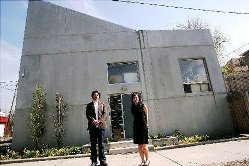
Designers and Jersey City residents Richard Garber (assistant professor at Nj Institute of Technology’s College of Architecture and Design in Newark) and Nicole Robertson of GRO Architects in Ny rose to the challenge of creating and managing the building of a single-family house that’s a true testament to both revolutionary design and environmental-friendly technology.
Denis Carpenter not too long ago invested in one small vacant lot and, to accomplish his interest for the environment, desired a residence that was environmentally friendly and very easy to maintain.
What's so unique about this home?
- Inside the home, on the floor level, radiant heating under the exposed concrete floor warms the full bathing room and a couple of bed rooms.
- In the loft-like second level, sleek aluminum and stainless steel railings accent the bamboo stairway to the mezzanine, living room and an artfully designed kitchen made with salvaged appliances and cabinetry.
- Passive cooling strategies like ceiling fans and clerestory windows permit occupants to be cool during summer and hot during winter.
- The roof consists of 260 sq . ft . of solar panels that supply about 2,000 kilowatts of energy per year to a battery stored in the basement.
- The root have a 2-foot-square area planted with drought-resist to collect rain .
This single family 1,600-square-foot home was constructed in six months and won a 2009 American Institute of Architects merit award and the 2010 Green Building of the Year Award from the Jersey City Redevelopment Agency.
So what now? How can you completely transform your home into an ecologically-friendly home without investing too much funds?
If you're redesigning a home, perform an energy review first to help you establish what energy efficiency changes should and can be made to your home. In this way you'll analyze how much energy your home consumes.
My personal favorite eco-friendly technique is the passive solar cooling/heating design.
Passive solar signifies that your home's windows, walls, and floors can be designed to collect, store, and distribute solar energy in the form of heat in the wintertime and reject solar heat in the summer time.
Existing structures can be adapted or "retrofitted" to passively collect and store solar heat too.
The next 5 aspects constitute a complete passive solar home design:
The Collector - The area through which sunlight enters the building (usually windows).
The Absorber - The hard, darkened surface of the storage element. Sunlight hits the surface and is absorbed as heat.
The Thermal Mass - The components that retain or store the heat generated by sunlight below or behind the absorber surface.
The Distributor - The method by which solar heat circulates from the collection and storage points to different areas of the house.
The Controller - Roof overhangs can be used to shade the aperture area during summer season or Thermostats that signal a fan to turn on.
The author - Cynthia Booth writes for the architecture career opportunities blog. It's a nonprofit website dedicated to offer help for beginning architects who need resources for their careers. With this she would like to enhance the interest on eco-friendly home design and change the general public perception of energy efficiency.